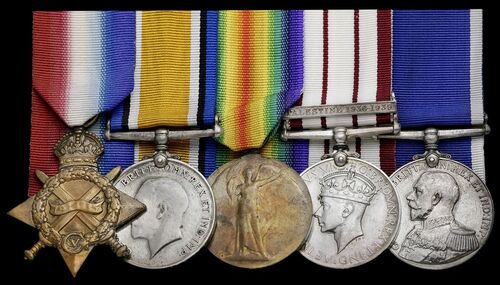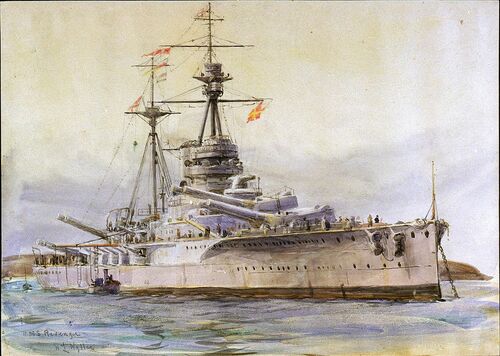Auction: 23001 - Orders, Decorations and Medals
Lot: 135
Five: Able Seaman C. G. Gulliver, Royal Navy, who saw heavy action at the Battle of Jutland with H.M.S. Revenge, landing weighty hits on Derfflinger and Von Der Tann
1914-15 Star (J.26310. C. G. Gulliver, A.B., R.N.); British War and Victory Medals (J.26310 C. G. Gulliver. A.B. R.N.); Naval General Service Medal, 1 clasp Palestine 1936-39 (J.26310 C. G. Gulliver A.B. R.N.); Royal Naval L.S. & G.C., G.V.R. (J.26310 C. G. Fulliver. A.B. H.M.S. Queen Elizabeth.), heavy contact wear, nearly very fine (5)
Cecil George Gulliver was born at Taunton, Somerset on 1 April 1897 and enlisted in the Royal Navy on 1 August 1913, being posted first to the shore establishment Impregnable. Still only Boy Class I upon the outbreak of the Great War Gulliver was posted to the Battlecruiser Tiger on 3 October 1914. Reaching his majority aboard this ship he was serving as an Ordinary Seaman with her when she took part in the Battle of Dogger Bank in January 1915.
Tiger fought as part of the 1st Battlecruiser Squadron alongside Admiral Beatty's own Lion in this action. She did not perform well however, partly as a result of communications errors but also because the crew assumed that the fire fall of shells from Lion was their own thus throwing out their aim. Nevertheless the Battle ended as a British victory which the German cruiser Blucher sunk and the Battlecruiser Seydlitz almost destroyed.
Gulliver was promoted after the engagement to the rank of Able Seaman on 5 August 1915. Posted ashore to Vivid I on 6 November 1915 he joined the company of the battleship Revenge on 1 February 1916. This ship formed part of the 1st Battle Squadron, part of the Grand Fleet under Admiral Jellicoe which sallied out to face the German High Seas Fleet on 31 May 1916.
Of the twenty-four ships in the British Line Revenge was the twenty-second and as such did not commence firing until shortly before the German formation began to bare away. At this stage Jellicoe had managed to cross the 'T' of his opponents' line and his vessels now formed a loose 'U' shape around the enemy fleet. In response to this situation Scheer sent out his battlecruisers to form a rear-guard, exposing them to the full firepower of the British fleet.
Revenge's closest enemy was Derfflinger which she began to hammer with remarkable success hitting her five times in a few minutes of shooting. One of Derfflinger's Gunnery officers described the effect of just one such hit stating:
'A 15-inch shell pierced the armour of 'Caesar' turret and exploded inside. The turret commander had both legs torn off and most of the gun crew was killed. The flames passed to the working chamber and then to the handling room and seventy-three of the seventy-eight men in the turret died'
At this stage Derfflinger was moving beyond her field of fire and Revenge switched focus to Von Der Tann making a successful hit on the conning tower which killed or wounded everyone within. After the Battle Gulliver remained with Revenge until the end of the war. Leaving her on 6 January 1921 Gulliver served with a number of vessels before joining H.M.S. Volunteer on 14 March 1924; sold together with a copied service record.
Subject to 20% VAT on Buyer’s Premium. For more information please view Terms and Conditions for Buyers.
Sold for
£210
Starting price
£80







